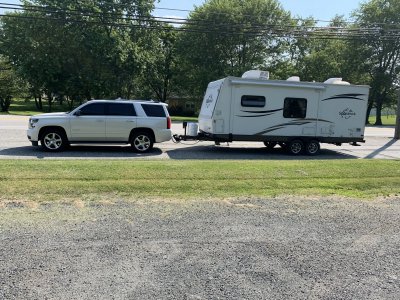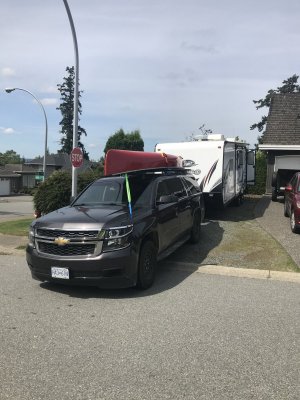View attachment 253058
It's hard to tell, but it looks as though the rear end of your Tahoe might be down a little. And the front might be up a little, which might mean a little less weight on the steering wheels and tires.
Did you weigh the trailer as loaded and get the tongue weight and axle weight and ensure that the tongue weight was 10-15% of the axle weight? Except for my first trip with a U-Haul trailer, I have had no trouble with sway with heavy trailers including a 24 foot Argosy, 31 foot Airstream, and a 34 foot Holiday Rambler. I always made sure the tongue weight was 10-15% of the total trailer weight.
For the last one, the 34 foot Holiday Rambler, I took it from where I bought it to some scales a couple of miles away to check weights on the way home. I understand manufacturers are more honest with weights than they used to be, but there can be a big difference between advertised empty weight without options and weight as delivered.
Also, my 2016 Tahoe owners manual says to adjust the weight distribution spring bars so that the height of the front wheel lip above the pavement is "...the same after coupling the trailer to the tow vehicle and adjusting the hitch." It doesn't say anything about having the engine running and the automatic leveling compressor active while adjusting the spring bars. My understanding was to adjust the spring bars and then start the engine. Do you see something in your manual which suggests otherwise?

![20200706_123853[1].jpg 20200706_123853[1].jpg](https://www.tahoeyukonforum.com/data/attachments/247/247919-28b6cc42ed001998e03164ce04c5c31e.jpg)
![20200702_124708[1].jpg 20200702_124708[1].jpg](https://www.tahoeyukonforum.com/data/attachments/247/247946-c662f412edc111f6006609bdc2f1e53c.jpg)

![20191011_082904[1].jpg 20191011_082904[1].jpg](https://www.tahoeyukonforum.com/data/attachments/247/247972-043efedc1491ea382ca1e451bb0bf7fc.jpg)
